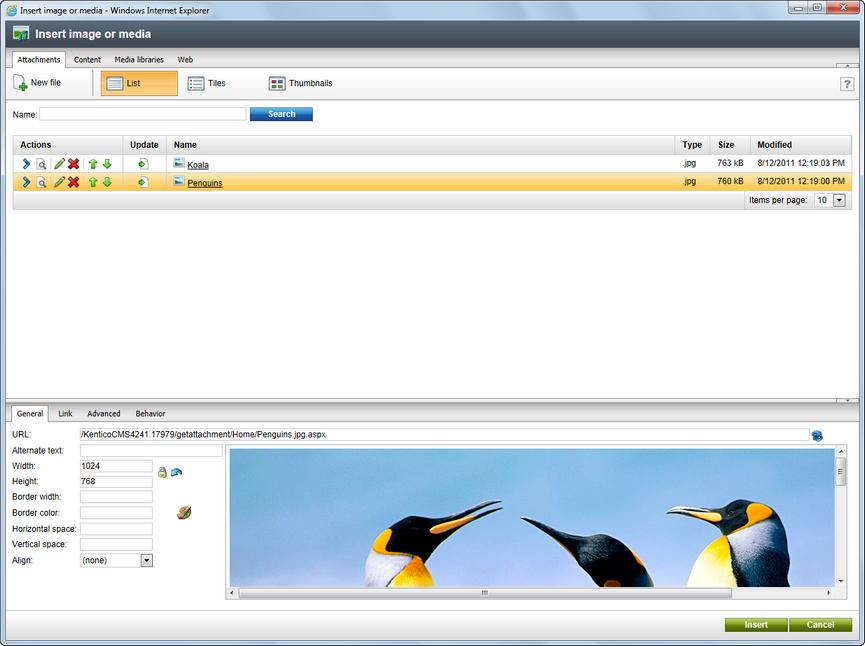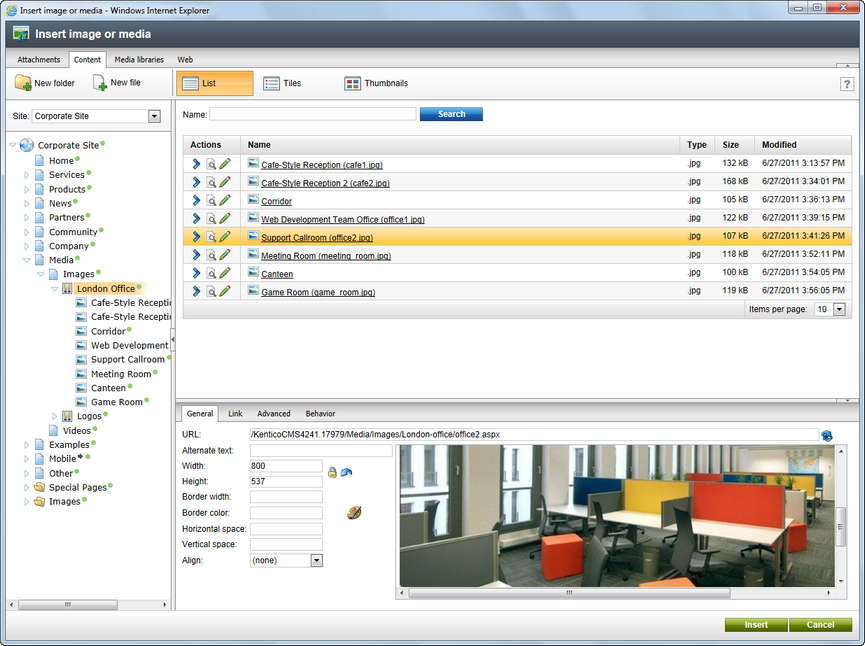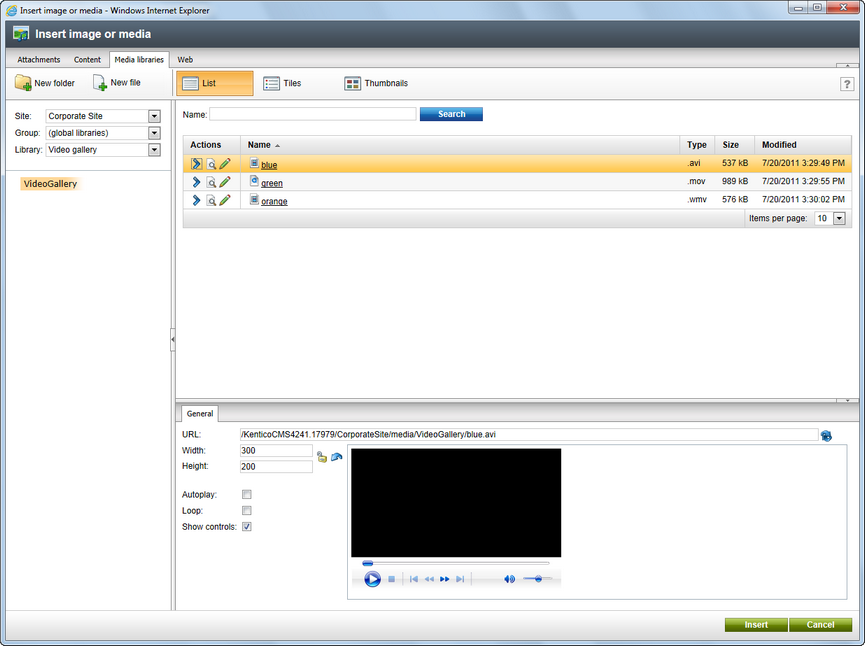File sources |

|

|

|

|
|
File sources |

|

|

|

|
|
|
||
Using the four tabs at the top of the dialog window, you can choose from where the image or media should be inserted. The following tabs are available:
The selection of files available on this tab depends on the location where the WYSIWYG editor is being used. When editing documents (e.g. on the Form tab, through user contributions etc.), the unsorted file attachments of the current document are offered. For more information about document attachments, please refer to the Document attachments chapter of this guide. When editing the content of other objects in the CMS (various types of layouts, e-mail templates etc.), this tab provides a way to insert the given object's metafile attachments.
From this tab, you can insert image attachments of the document into the text. You can select an attachment using the Select (![]() ) icon or by simply clicking the appropriate line (or tile/thumbnail in the other view modes).
) icon or by simply clicking the appropriate line (or tile/thumbnail in the other view modes).
You can upload new attachments using the ![]() New file button. The following actions can be performed with the listed attachments:
New file button. The following actions can be performed with the listed attachments:
•After clicking the View (![]() ) icon, the attachment will be opened in a new window.
) icon, the attachment will be opened in a new window.
•Using the Delete (![]() ) icon, you can remove the attachment from the document.
) icon, you can remove the attachment from the document.
•Using the Move up (![]() ) and Move down (
) and Move down (![]() ) icons, you can change the order of document attachments. This option is available only in the List view mode. The order is stored in the AttachmentOrder property of each attachment. You can enter AttachmentOrder into the ORDER BY expression property of a displaying web part to have the attachments ordered accordingly.
) icons, you can change the order of document attachments. This option is available only in the List view mode. The order is stored in the AttachmentOrder property of each attachment. You can enter AttachmentOrder into the ORDER BY expression property of a displaying web part to have the attachments ordered accordingly.
•Using the Edit (![]() ) icon, you can edit the metadata of the file. However, clicking this icon placed beside an image opens the image in the built-in image editor.
) icon, you can edit the metadata of the file. However, clicking this icon placed beside an image opens the image in the built-in image editor.
•Using the Update (![]() ) icon, you can replace the original attachment with a new one.
) icon, you can replace the original attachment with a new one.

From this tab, you can insert files stored in the content tree of any of the sites running in the system. The site to insert from can be selected using the Site drop-down list, while its content tree will be displayed below. You can define which sites will be available. You can also define the starting alias path of the displayed content tree when defining a field in the field editor, as described in the Dialog configuration topic.
If you select a node of the content tree, all insertable files stored under it will be listed in the main area. You can filter the listed files by Name, Type, Size and the time when the files were Modified using the filter above the list.
You can select a file using the Select (![]() ) icon or by simply clicking the appropriate line (or tile/thumbnail in the other view modes).
) icon or by simply clicking the appropriate line (or tile/thumbnail in the other view modes).
New folders (cms.folder documents) can be created in the content tree via this dialog using the New folder (![]() ) button. You can also upload new files (cms.file documents) into the content tree using the New file (
) button. You can also upload new files (cms.file documents) into the content tree using the New file (![]() ) button. The following actions can be performed with the listed files:
) button. The following actions can be performed with the listed files:
•After clicking the View (![]() ) icon, the file will be opened in a new window.
) icon, the file will be opened in a new window.
•Using the Edit (![]() ) icon, you can edit metadata of the file. However, clicking this icon placed beside an image opens the image in the built-in image editor.
) icon, you can edit metadata of the file. However, clicking this icon placed beside an image opens the image in the built-in image editor.

From this tab, you can insert files stored in a media library. Depending on the settings described in the Dialogs configuration topic, you can select a library using the set of three drop-down lists - Site, Group and Library - in the top right part of the dialog.
More information about Kentico CMS Media libraries can be found in the Modules -> Media libraries chapter.
When a library is selected, its folder structure is displayed below the drop-down lists. After selecting a folder, its content will be offered in the main area. You can filter the listed files by Name, Type, Size and the time when the files were Modified using the filter above the list.
You can select a file using the Select (![]() ) icon or by simply clicking the appropriate line (or tile/thumbnail in the other view modes).
) icon or by simply clicking the appropriate line (or tile/thumbnail in the other view modes).
You can also perform the following actions with the listed files:
•After clicking the View (![]() ) icon, the file will be opened in a new window.
) icon, the file will be opened in a new window.
•Using the Edit (![]() ) icon, you can edit metadata of the file. However, clicking this icon placed beside an image opens the image in the built-in image editor.
) icon, you can edit metadata of the file. However, clicking this icon placed beside an image opens the image in the built-in image editor.

From this tab, you can enter an image, audio, video or flash from the web by entering its URL. More information on how to use this tab can be found in the Inserting images or media from the Web topic.
